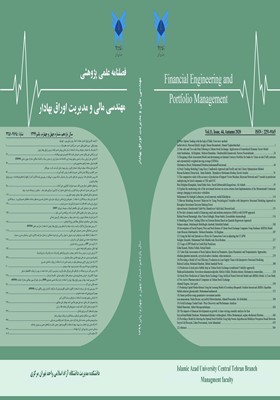کاربرد مدل ZPP در پیشبینی ریسک اعتباری
محورهای موضوعی : مهندسی مالیالهه کمالی 1 , میرفیض فلاح 2 , فرهاد حنیفی 3
1 - گروه مدیریت بازرگانی، واحد تهران مرکز، دانشگاه آزاد اسلامی، تهران، ایران
2 - گروه مدیریت بازرگانی، واحد تهران مرکز، دانشگاه آزاد اسلامی، تهران، ایران
3 - گروه مدیریت بازرگانی، واحد تهران مرکز، دانشگاه آزاد اسلامی، تهران، ایران
کلید واژه: ریسک اعتباری, احتمال نکول, کیاموی, ZPP,
چکیده مقاله :
موضوعات مربوط به ریسک اعتباری و روشهایی برای شناسایی و پیشبینی آن در چند دهه گذشته به طور مداوم در حال پیشرفت است. هنگامی که یک شرکت مشکل مالی را تجربه می کند، ممکن است قادر به انجام تعهدات مالی خود نباشد، که میتواند باعث زیان مالی مستقیم و غیر مستقیم به سهامداران، اعتباردهندگان، تامین کنندگان مالی و همچنین سایر افراد در جامعه شود. مدلهای پیشرفته ریسک اعتباری که بر مبنای ارزش بازار است، بهبود کیفیت اعتباری و همچنین افت یا تنزل رتبه اعتباری لحاظ میگردد. در پژوهش پیش رو دو مدل از مدلهای پیشرفته ریسک اعتباری را مورد آزمون قرار دادهایم بنابراین دو نمونه انتخاب کرده یعنی شرکتهایی که دارای مشکلات مالی هستند و شرکتهایی که دارای سلامت مالی میباشند و در هر گروه احتمال نکول را از طریق دو مدل KMV وZPP برآورد کرده و سپس احتمالات نکول را با یکدیگر مقایسه کرده و به این نتیجه رسیدیم که توانایی پیشبینیکنندگی مدل ZPPدر مقایسه با مدل KMV بیشتر است.مدل(ZPP) روشی جدید برای پیشبینی احتمال نکول است که مخفف مدل احتمال قیمت صفر میباشد. تمرکز اصلی آن نسبت به مدلهای قدیمیتر، بیشتر بر رویکرد مبتنی بر شبیه سازی است.
Credit risk issues and methods for identifying and predicting it have been constantly evolving over the past few decades. When a company deals with a financial problem, it may not be able to fulfill its financial obligations, which can cause direct and indirect financial losses to shareholders, creditors, investors and other people in the community. Advanced credit risk models that are based on market value include improving credit quality as well as reducing or decreasing credit ratings. In the present study, we have Investigated two models of advanced credit risk models, so two samples were selected, namely companies with financial problems and companies with financial health, in each group probabilities of default are estimated by two models which are KMV and ZPP, and then we compared probabilities of default. We have concluded that the ZPP model has more predictive ability than the KMV model.This method is denoted the Zero-Price Probability or simply the ZPP model. The main focus is on the new simulation based approach rather than the older established models.
_||_
Ahmadi, Ramin and Mohammad Ali Rostgar, 2016, Examining the default point of legal clients of banks with KMV hybrid models: Companies admitted to Tehran Stock Exchange, 14th International Industrial Engineering Conference, Tehran, Iran Industrial Engineering Association - Alam University and Iranian industry.
2) Kosha, Rozita and Mohammadreza Abbaszadeh, 2016, the effect of stock liquidity on default risk in Tehran Stock Exchange companies, National Conference on Modern Researches in Management and Accounting, Isfahan, Sheikh Bahai University
3) Asghari, M., Khansari, R., and Siahkarzadeh, M. (1386). Examining credit risk portfolio models and necessary infrastructures for their application in the banking industry. Knowledge reference site (Civilika), Imam Sadegh University.
4) Panah Azari, Sh., and Fallahshams, M. (2012). Investigating the relationship between default and capital structure using KMV model and panel data method. Scientific Research Quarterly Journal of Financial Knowledge of Securities, No. 18.
5) Talebi, M. (2013). Investigating the relationship between the probability of default and financial flexibility in the Iranian capital market using the KMV model. Islamic Azad University, Arak branch.
6) Bharath, S. T., & Shumway, T. (2008). Forecasting default with the Merton distance to default model. Review of Financial Studies, 21, 1339-1369.
7) Crosbie, P. J., & B. (2002). Modeling default risk. Research Paper, Moody's KMV.
8) Crouhy, M., Mark, R., & Galai, D. (2010). Risk Management (2nd edition). McGraw-Hill Professional.
9) Elizalde, A. (2005). Credit Risk Models II: Structural Models.
10) Falavigna, G. (2006). Models for Default Risk Analysis Focus on Artificial Neural Networks, Model Comparisons, Hybrid Frameworks. Ceris-Cnr and University of Bergamo.
11) Fantazzini, D., Giuli, M. E. De, & Maggi, M. (2007). A New Approach for Firm Value and Default Probability Estimation beyond Merton Models. Moscow School of Economics, 23.
12) Göransson, P., & Grétarsson, Ì. A. (2008). A COMPARATIVE STUDY BETWEEN THE KMV AND THE ZERO-PRICE PROBABILITY FOR DEFAULT PREDICTION. University of Lund.
13) Kealhofer, S., & Kurbat, M. (2000). Benchmarking quantitative default risk models: A validation methodology. Research Paper, Moody's KMV.
14) Kealhofer. (2003). Quantifying credit risk i: default prediction. Financial Analysts Journal, 30–44.
15) Lento, C., & Gradojevic, N. (2013). The Effectiveness of Option Pricing Models During Financial Crises. In Rethinking Valuation and Pricing Models. https://doi.org/10.1016/B978-0-12-415875-7.00001-4
16) Trueck, S., & T. Rachev, S. (2009). Rating Based Modeling of Credit Risk. Elsevier.
17) Zhang, X. (2017). Essays in Credit Risk Management. University of Glasgow.


